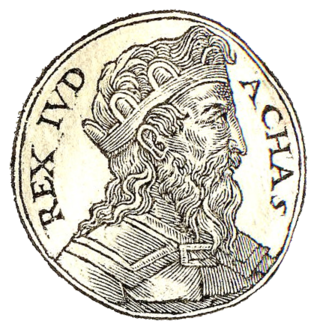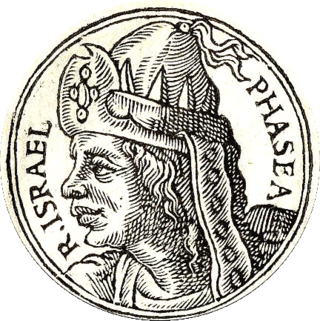Related Research Articles

The Kingdom of Israel, or the Kingdom of Samaria, was an Israelite kingdom in the Southern Levant during the Iron Age. The kingdom controlled the areas of Samaria, Galilee and parts of Transjordan. The regions of Samaria and Galilee underwent a period with large number of settlements during the 10th century BCE, with the capital in Shechem, and then in Tirzah. The kingdom was ruled by the Omride dynasty in the 9th century BCE, whose political center was the city of Samaria.
The 8th century BC started the first day of 800 BC and ended the last day of 701 BC. The 8th century BC was a period of great change for several historically significant civilizations. In Egypt, the 23rd and 24th dynasties lead to rule from Nubia in the 25th Dynasty. The Neo-Assyrian Empire reaches the peak of its power, conquering the Kingdom of Israel as well as nearby countries.
The 10th century BC comprises the years from 1000 BC to 901 BC. This period followed the Late Bronze Age collapse in the Near East, and the century saw the Early Iron Age take hold there. The Greek Dark Ages which had come about in 1200 BC continued. The Neo-Assyrian Empire is established towards the end of the 10th century BC. In the Iron Age in India, the Vedic period is ongoing. In China, the Zhou dynasty is in power. Bronze Age Europe continued with Urnfield culture. Japan was inhabited by an evolving hunter-gatherer society during the Jōmon period.
The 1050s BC is a decade which lasted from 1059 BC to 1050 BC.
This article concerns the period 739 BC – 730 BC.
The 930s BC is a decade which lasted from 939 BC to 930 BC.
The 990s BC is a decade which lasted from 999 BC to 990 BC.

Ahaz an abbreviation of Jehoahaz II, "Yahweh has held" was the twelfth king of Judah, and the son and successor of Jotham. Ahaz was 20 when he became king of Judah and reigned for 16 years.

Tiglath-Pileser III, was the king of the Neo-Assyrian Empire from 745 BC to his death in 727. One of the most prominent and historically significant Assyrian kings, Tiglath-Pileser ended a period of Assyrian stagnation, introduced numerous political and military reforms and more than doubled the lands under Assyrian control. Because of the massive expansion and centralization of Assyrian territory and establishment of a standing army, some researchers consider Tiglath-Pileser's reign to mark the true transition of Assyria into an empire. The reforms and methods of control introduced under Tiglath-Pileser laid the groundwork for policies enacted not only by later Assyrian kings but also by later empires for millennia after his death.

Pekah was the eighteenth and penultimate king of Israel. He was a captain in the army of king Pekahiah of Israel, whom he killed to become king. Pekah was the son of Remaliah.

Shalmaneser V was the king of the Neo-Assyrian Empire from the death of his father Tiglath-Pileser III in 727 BC to his deposition and death in 722 BC. Though Shalmaneser V's brief reign is poorly known from contemporary sources, he remains known for the conquest of Samaria and the fall of the Kingdom of Israel, though the conclusion of that campaign is sometimes attributed to his successor, Sargon II, instead.

Hoshea was the nineteenth and last king of the Israelite Kingdom of Israel and son of Elah. William F. Albright dated his reign to 732–721 BCE, while E. R. Thiele offered the dates 732–723 BCE.

Menahem or Menachem was the sixteenth king of the northern Israelite Kingdom of Israel. He was the son of Gadi, and the founder of the dynasty known as the House of Gadi or House of Menahem.
Tiglath-Pileser may refer to:
Tiglath-Pileser II was King of Assyria from 967 BCE, when he succeeded his father Ashur-resh-ishi II, until his death in 935 BCE, when he was succeeded by his son Ashur-dan II. Little is known about his reign.
The King of Tyre was the ruler of Tyre, the ancient Phoenician city in what is now Lebanon. The traditional list of 12 kings, with reigns dated to 990–785 BC, is derived from the lost history of Menander of Ephesus as quoted by Josephus in Against Apion I. 116–127. Josephus asserts that Menander had drawn his list from the chronicles of Tyre itself. Menander-Josephus also contains a list of 9 kings and judges, with reigns dated to 591–532 BC in Against Apion I. 154–160.
Rezin of Aram was an Aramean King ruling from Damascus during the 8th century BC. During his reign, he was a tributary of King Tiglath-Pileser III of Assyria.
Hiram II (Hi-ru-mu) was the Phoenician king of Tyre from 737 to 729 BC. In 738 he was listed as a tributary of the Assyrian king Tiglath-pileser III. His predecessor, Ithobaal II, was also stated to have paid tribute in that year. It is possible that the date in the Assyrian record is in error and Hiram's reign did not begin until 737. Hiram II should not be identified with the "Hiram, king of the Sidonians" who paid tribute to the Assyrians at an earlier date.

2 Kings 16 is the sixteenth chapter of the second part of the Books of Kings in the Hebrew Bible or the Second Book of Kings in the Old Testament of the Christian Bible. The book is a compilation of various annals recording the acts of the kings of Israel and Judah by a compiler in the seventh century BCE with a supplement added in the sixth century BCE. This chapter records the events during the reign of Ahaz, the king of Judah.
References
- ↑ "Was Tiglath-pileser III a Usurper?", Tiglath-pileser III, Founder of the Assyrian Empire, SBL Press, pp. 25–42, 2022-07-21, doi:10.2307/j.ctv2r4kxpx.7 , retrieved 2022-07-24